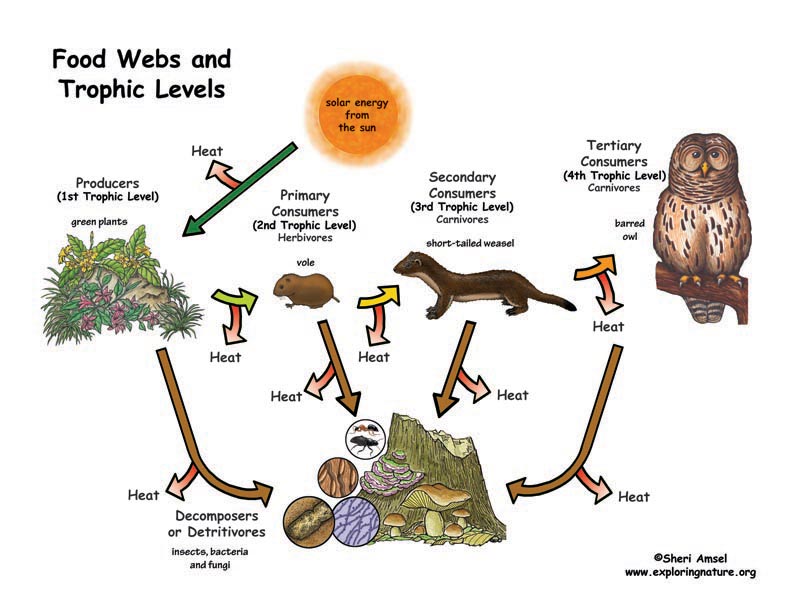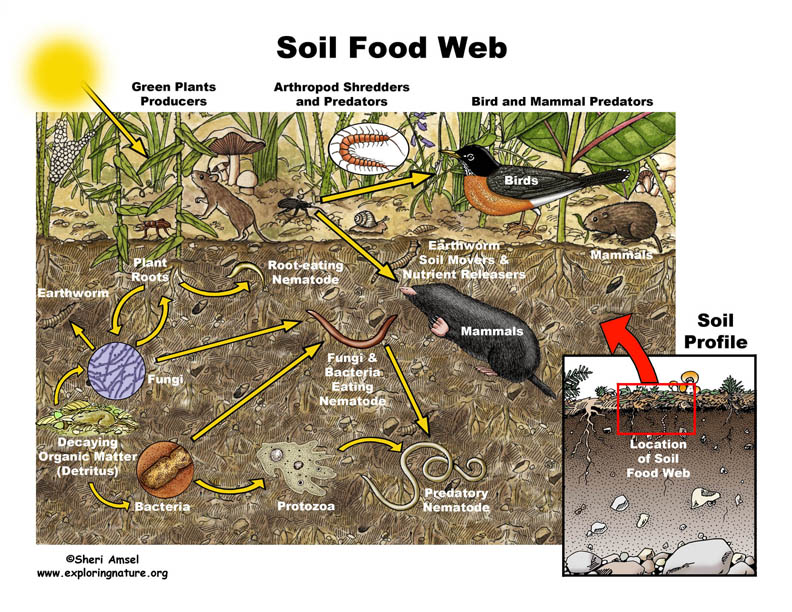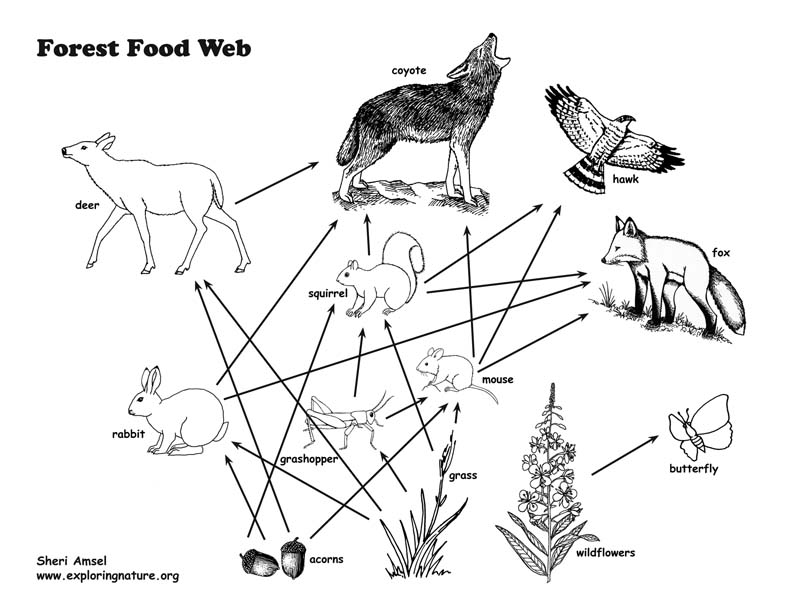

Performance Expectations Students who demonstrate understanding can:
5-LS2-1. Develop a model to describe the movement of matter among plants, animals, decomposers, and the environment. [Clarifcation Statement: Emphasis is on the idea that matter that is not food (air, water, decomposed materials in soil) is changed by plants into matter that is food. Examples of systems could include organisms, ecosystems, and the Earth.] [Assessment Boundary: Assessment does not include molecular explanations.]
_________________________________________________________________________________________________________________________________________________________
Use the Template and Resource Links to Fulfill NGSS
l. Goals:
Essential Questions:
NGSS Note: Think, question, entertain ideas.
ll. Introductory Activities to Assess Prior Knowledge
A. Simple Activities - that assess students’ understanding of food webs.
B. Brainstorming Sessions
Question: What are some of the food webs found in your local habitats?
1. Break students down into groups of 3-4.
2. Ask students to create a food web with all the relevant parts from one of their local habitats (i.e. forest, pond, park, field, etc.)
3. Discuss
lll. New Knowledge - Text
A. Read about foodwebs:
Food Webs - The Nutrient Cycle
About Food Webs and Trophic Levels
Soil Food Web
Food Webs Explained - Poster
B. Examples of Models (depicts the concept expressed in the reading):
Ask students to look at the models and explain how each illustrates the concepts they've read about.
A. Critical Thinking Activities related to food webs:
Building a Forest Food Web Activity
Name the Parts of a Food Web
Trophic Levels - Graphic Organizer
B. Authentic Performance - Understanding by Design (UbD) assessment tool.
Use critical thinking to complete thse Authentic Performance Activities and deepen your understanding about the above topics.
V. Summarize Knowledge - Enduring Understandings
Vl. Next Generation of Science Standards (NGSS) - Grade 5
Disciplinary Core Ideas
LS2.A: Interdependent Relationships in Ecosystems
•The food of almost any kind of animal can be traced back to plants. Organisms are related in food webs in which some animals eat plants for food and other animals eat the animals that eat plants. Some organisms, such as fungi and bacteria, break down dead organisms (both plants or plants parts and animals) and therefore operate as “decomposers.” Decomposition eventually restores (recycles) some materials back to the soil. Organisms can survive only in environments in which their particular needs are met. A healthy ecosystem is one in which multiple species of different types are each able to meet their needs in a relatively stable web of life. Newly introduced species can damage the balance of an ecosystem. (5-LS2-1)
LS2.B: Cycles of Matter and Energy Transfer in Ecosystems
• Matter cycles between the air and soil and among plants, animals, and microbes as these organisms live and die. Organisms obtain gases, and water, from the environment, and release waste matter (gas, liquid, or solid) back into the environment. (5-LS2-1)
Science and Engineering Practices (NGSS)
Developing and Using Models
Modeling in 3–5 builds on K–2 models and progresses to building and revising simple models and using models to represent events and design solutions.
• Develop a model to describe phenomena. (5-LS2-1)
Connections to the Nature of Science
Science Models, Laws, Mechanisms, and Theories Explain Natural Phenomena
• Science explanations describe the mechanisms for natural events. (5-LS2-1)
Crosscutting Concepts
Systems and System Models
• A system can be described in terms of its components and their interactions. (5-LS2-1)
Performance Expectations
Students who demonstrate understanding can:
5-LS2-1. Develop a model to describe the movement of matter among plants, animals, decomposers, and the environment. [Clarifcation Statement: Emphasis is on the idea that matter that is not food (air, water, decomposed materials in soil) is changed by plants into matter that is food. Examples of systems could include organisms, ecosystems, and the Earth.] [Assessment Boundary: Assessment does not include molecular explanations.]
Common Core State Standards Connections
ELA/Literacy
RI.5.7 Draw on information from multiple print or digital sources, demonstrating the ability to locate an answer to a question quickly or to solve a problem efficiently. (5-LS2-1)
SL.5.5 Include multimedia components (e.g., graphics, sound) and visual displays in presentations when appropriate to enhance the development of main ideas or themes. (5-LS2-1)
Mathematics
MP.2 Reason abstractly and quantitatively. (5-LS2-1)
MP.4 Model with mathematics. (5-LS2-1)
When you research information you must cite the reference. Citing for websites is different from citing from books, magazines and periodicals. The style of citing shown here is from the MLA Style Citations (Modern Language Association).
When citing a WEBSITE the general format is as follows.
Author Last Name, First Name(s). "Title: Subtitle of Part of Web Page, if appropriate." Title: Subtitle: Section of Page if appropriate. Sponsoring/Publishing Agency, If Given. Additional significant descriptive information. Date of Electronic Publication or other Date, such as Last Updated. Day Month Year of access < URL >.
Amsel, Sheri. "Grade 5 - 5-LS2 Ecosystems: Interactions, Energy, and Dynamics" Exploring Nature Educational Resource ©2005-2024. December 13, 2024
< http://exploringnature.org/db/view/1964 >




